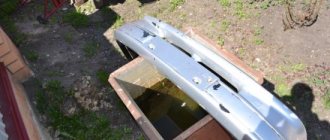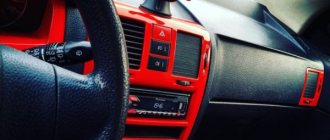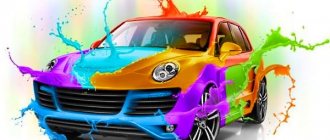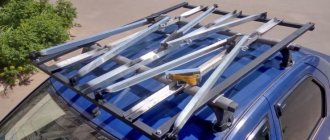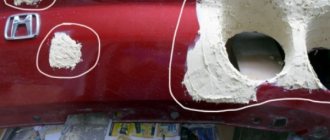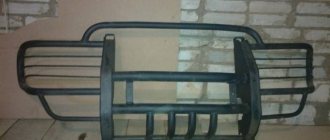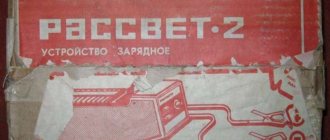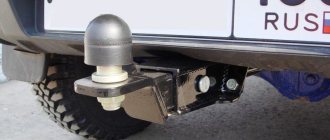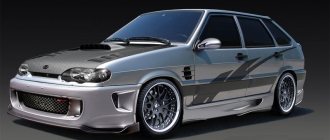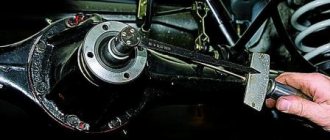Comments: no Published: 03/30/2016
Rating:
Tags:VAZ 2121How to apply paint and varnishVarnishes and paint
It is not surprising that many car owners try to somehow distinguish their vehicle from the mass of other cars. For this, various methods of tuning and restyling are used - these are special methods of painting a car, pasting the body with vinyl films, and various types of lighting. A very common type of car tuning is painting in camouflage.
Car tuning using camouflage paint
This method is especially common among off-road vehicle owners. This is understandable: SUVs are quite often used in the wild, where camouflage paint looks quite appropriate. Well, on city streets, a car in camouflage looks like an experienced traveler who has wandered into a social party for a while to take a break from adventure.
The Niva car can be classified as one of those cars for which camouflage painting is popular. As a rule, fishing and hunting enthusiasts own such a car, so this color is very much appreciated among them.
To paint the Niva in this way, you can contact specialists at a car service station - this is the easiest way. But if you want to avoid unnecessary financial expenses and control the process from start to finish, you can do this work yourself. In fact, there is nothing complicated about this - you just need to study the entire process well and stock up on special tools and materials.
Painting a car in camouflage
How to paint a car in a camouflage uniform?
The military style has spread not only in the fashion world.
Today, the color of protection is often found in automotive infrastructure. Officers, former military men and simply drivers, who are not indifferent to military regulations, choose an unusual exterior in the form of spots of various shades for their iron friend. Everyone can learn how to paint a car in camouflage on their own. For painting work you will need:
Also useful for work:
After the working kit is prepared, you need to select the type of painting in camouflage color:
Depending on the type of drawing applied, there are paintings of varying degrees of complexity:
The last option is notable for its complexity.
For those who do not have painting experience, it is better to entrust painting under camouflage to professionals or watch a video of how specialists carry out this task. A car painted in metallic color will look very nice. But this, as they say, is a matter of taste.
Painting a car in camouflage - video tutorial.
Detailed instructions
The first step is to choose what color scheme to decorate the car with. Here it is worth mapping out the location of the colors and in what order they should be applied. According to technology, the spots should overlap, covering the edges of other colors.
In practice, painting a car in camouflage begins with preparing the body: degreasing, priming.
The entire car body is covered with a base color using quick-drying nitro paint (complete hardening - 20 minutes).
After the coating has dried, you can glue the pre-prepared plotter film molds. Here it is worth choosing materials made in China that have weak adhesive ability. After its removal, no traces remain on the paintwork.
The second color, lighter, is applied in the middle layer. It dries up.
Then the stencils are applied again, the procedure is similarly repeated from the third stage another 3-4 times with different colors.
To preserve the effect, the freshly applied paint coating is varnished.
If you are unable to get a plotter, you can use masking tape. However, you will have to be patient.
When painting camouflage, it is undesirable to apply small spots.
For a small SUV, the norm is 5-6 marks of different shades.
It is unacceptable to paint more than half of the body surface with camouflage without indicating changes in the car’s registration certificate.
How to paint a car using vinyl film?
The paintwork has an alternative - polyvinyl chloride film with a military pattern. If you have no painting experience, but still want to get taiga camouflage, then you need to do the following:
Those who are interested in car restyling will be able to continue the military theme inside the cabin.
So, having studied the methods of creating camouflage paints, making your own car unique, noticeable in the city and invisible in the forest is easier than it seems at first glance. A detailed description and video materials will help in performing painting work. It remains to wish good luck to those who really set themselves the goal of restyling to a camouflaged car.
Expert: Andrey Volkov.
Administrator
Interior features
The manufacturer has not yet provided clear information about what the interior of the new product will look like; it is quite possible that some changes and improvements will be made to the existing characteristics. Today only the following is known:
- It was promised to use higher quality materials, develop a completely new interior design, and add useful options, although it is not yet clear which ones exactly.
- Most likely, the car will not have any frills and will remain utilitarian in order to remain in the segment of inexpensive models available to buyers.
- It is planned to maintain the functionality of the car, although making it more convenient to use.
- Perhaps climate control will be added, top trim levels will receive heated windshields and mirrors, mirrors will fold and remember their position, but for now these are just plans, it is unknown whether they will be implemented and to what extent.
We paint a car in camouflage - the procedure for transforming a car
A special camouflage pattern will help you stand out among other motorists or prepare your car for hunting. You can use film pasting or a rather complex procedure for applying camouflage paint. And if there is nothing to say about the film - you just need to stick it correctly according to the instructions - then with painting the situation is much more complicated. Today we will talk about how to apply camouflage to a car using paint. You can assume that a car painted by yourself may not look the same as the cars in professional photos.
The problem is that painting your car even without using camouflage patterns will not be easy. But applying several layers of different colors with clear boundaries and not rough geometric shapes sometimes seems completely impossible. Therefore, painting a car in camouflage is considered one of the most difficult options for transforming a vehicle. It is worth carrying out this work with a decent understanding of technology and all painting tools.
Painting a car in camouflage with your own hands - stages and tasks
If you have chosen the option of painting your car, you need to decide on the type of pattern. We will talk about choosing a pattern below, but for now we will touch on the technical aspects of completing the task. Painting in camouflage requires the artist to understand all stages of painting work. The body preparation must be perfect, unevenness is not allowed. The choice of paint is also quite important. During the coloring process you can use simple methods:
And if painting a car in camouflage is done for decorative purposes, you can use regular enamel in the middle price category. Using a car for hunting or off-road requires better surface preparation. You can watch videos in which experts talk about the requirements of the material, as well as painting methods in this case. To successfully solve the problem, it is important not just to paint the body, but to provide it with the necessary characteristics for use.
Choosing a good camouflage color and type for the car
If we are talking about winter preparation of transport for hunting, you can use white colors with camouflage elements. If you take a closer look at the photos of owners of SUVs and other types of vehicles, you can see blue, red colors in camouflage and other unusual solutions. Such camouflage on a car solves specific problems or simply serves to attract attention and stand out from other representatives on the road.
You can learn how to paint a car camouflage, just watch popular videos on the topic and evaluate the work of specialists. But be careful with such training options, since many video creators tell a lot of false things, while they themselves do not know how to paint a car in camouflage. Choose a pattern that you can recreate with your own hands without the help of specialists.
Owner comments and reviews:
1.Passing corrosion...? 2.What color is purple? 3.Color golden brown? I like the car, but it’s not clear how well it’s made. Guarantees? As soon as I have the money, I’ll buy it right away! To stand and make you happy! Golden brown CoryAndrey. I’m ready to take it, but first I need to change my driver’s license. I would like a detailed comparative analysis of this car with cars of other brands. Write, research and write, without changing the main thing, improving the centenarian with simple, high-quality means. One hundred years to you, Bronto. Lada.
How to paint a car camouflage with your own hands? Practical beauty
Many drivers who prefer SUVs are interested in how to paint a car camouflage color with their own hands. This color is liked by most hunters and jeepers. This color is ideal for SUVs (Land Rover Defender, UAZ, Niva, Volkswagen Touareg). Any crossovers also look good (Kia Sportage, Hyundai ix35). And this coloring will not look at all on small city cars. In fact, giving a car this color is not such a difficult task. The main thing is to do everything right.
How to paint a car camouflage color with your own hands? There are several types of camouflage colors. Each variety has its own origin, characteristics and is used in different situations.
To choose a color, you need to determine how and where the machine will be used. For most options, forest or hunting camouflage is suitable. For trips on winter hunting and fishing, you should select the appropriate colors.
Article on the topic “The best SUVs for hunting and fishing.”
Methods
It is important for the master to know all the methods of painting under camouflage. There are two main methods. Stencil
– the design is applied using special stencils. The drawing turns out quite beautiful. But at the same time, it is even and does not always cope with its camouflage task.
Manual
– the drawing is done using a brush. This camouflage is the most successful. It turns out to achieve a perfectly blurred texture.
The second method of application is the most difficult to produce. It is used to create hunting camouflages. Other species are created a little less frequently using this method. For digital protective painting, it is best to use the stencil painting method. When and where to paint?
The most optimal time is summer. It’s better for the paint to go on and dry at just such a time. In winter, you will need a warm, dry room for painting. The box must be well ventilated.
Be sure to eliminate all possible sources of dust. Otherwise, the coating will not be effective.
Stencil method
You will need pre-prepared stencils. You can buy them, but it is much easier to make your own. To do this, take newspapers or any thin paper. Cut pieces of this material into suitable shapes.
Other materials you will need are the following.
This amount of materials should be enough.
Technology
First you need to prepare the car. This action is no different from other types of auto painting work. Be sure to treat the car with gasoline. All swollen areas of paint are removed with a spatula and cleaned. After this, the body is primed; before doing this, be sure to degrease the surface.
Manual method
This method is more complex. Instead of spray cans, paint is purchased in cans. You will also need brushes with medium-hard bristles. The main stages of preparation do not differ from the previous method. The difference is in the application of the stains. Here they are applied manually using a brush. The main feature is the ability to make the edges of camouflage spots blurred, which increases the effectiveness of painting.
Hunting camouflage is made this way. To do this, use a brush to paint leaves and blades of grass.
Conclusion:
Protective colors are almost never factory-made; lovers of outdoor trips have to finish the car themselves. Before you paint your car camouflage color yourself, decide what color you want. The process itself does not require any special skills.
Using a minimum of equipment, you can achieve optimal results.
Price Lada 4x4 3-door. Bronto 2021
- 1.7 l. 8th grade (83 hp), 5MT / Standard – RUB 528,700.
- 1.7 l. 8th grade (83 hp), 5MT / Standard / Image - 528,700 rub.
- 1.7 l. 8th grade (83 hp), 5MT / Standard / Camouflage – RUB 528,700.
- 1.7 l. 8th grade (83 hp), 5MT / Standard / Image / Camouflage – RUB 528,700.
As for the body colors, three-door cars have 8 body color options, and 5-door cars have 7 color options. In addition, the Bronto version can be painted in camouflage colors. The entire range of colors available for Niva in 2022 is shown below in the picture.
Equipment Lada 4x4 “Standard”
The basic version “Standard” is the most affordable. The engine is a 1.7 liter 8-valve engine with a power of 83 hp. and 5-st. Mechanics. The list of options is quite small, since introducing airbags or a multimedia system would require serious modifications to the model. But now the manufacturer is not set up for this. After all, a new generation of Lada 4x4 is being developed, which will already have all this. The package includes the following options: • ISOFIX child seat mounts • Daytime running lights • Anti-lock brakes with brake assist system (ABS+BAS) • Electronic brake force distribution (EBD) • 12V socket • 12V socket in the luggage compartment • Power steering controls • Light tinting of windows • Power windows for front doors • Audio preparation • 16 inch steel wheels with Pirelli tires • Spare full-size steel wheel R16
Equipment Lada 4x4 “Lux”
The Luxe version adds heated front seats and alloy wheels. For the air conditioner you will need to pay another 22 thousand rubles.
Equipment Lada 4x4 “Urban”
It already has air conditioning, metallic paint, different bumpers, alloy wheels, front windows, electric drive and heated exterior mirrors and additional sound insulation.
Equipment Lada 4x4 “Bronto”
The Bronto version is perhaps the most interesting. Here, buyers are offered different bumpers, toothy tires, roof rails, reinforced springs and shock absorbers, a reinforced rear axle, self-locking front and rear differentials, there is additional anti-gravel protection for the wheel arches and rubber flares on the wheel arches.
DIY camouflage painting of Niva
VAZ 2121How to apply paint and varnishVarnishes and paint
It is not surprising that many car owners try to somehow distinguish their vehicle from the mass of other cars. For this, various methods of tuning and restyling are used - these are special methods of painting a car, pasting the body with vinyl films, and various types of lighting. A very common type of car tuning is painting in camouflage.
Car tuning using camouflage paint
This method is especially common among off-road vehicle owners. This is understandable: SUVs are quite often used in the wild, where camouflage paint looks quite appropriate. Well, on city streets, a car in camouflage looks like an experienced traveler who has wandered into a social party for a while to take a break from adventure.
Best combinations
Combining sand shades with others is quite simple. The main thing is that the chosen set looks harmonious and suits the woman.
White
The combination of dusty khaki shades and white is a win-win option. Few people will be indifferent to a look in which a white shirt is worn with a protective trench coat.
Grey
Teaming up with grey, protective shades will play a major role. If you want to focus on the raincoat, feel free to combine it with gray things.
Black
This combination will give the image restraint and severity. In order not to look completely gloomy, it is better to intertwine light shades of dusty khaki with black.
This combination looks attractive with light shades of sand.
The most stylish combination for informal occasions is with blue denim.
How to paint a car camouflage?
Translated from French, “camouflage” means “camouflage.” Initially, camouflage coloring was the prerogative of military and special vehicles, providing covert movement across the terrain. Due to a special combination of colors, the effect of visual merging with the environment is achieved, reducing the likelihood of detection by an enemy or a tracking object.
Over time, the specific color of cars became fashionable. Tuning “under camouflage” is very popular among young people. The characteristic “spotted” and “pixelated” colors can be seen on ordinary passenger cars. For ordinary car enthusiasts, painting a car in camouflage has acquired a meaning that is the opposite of its original meaning: now it is a way to attract attention and stand out among the same and boring color scheme of assembly line cars.
Types of camouflage colors
Historical military traditions have formed the main classification of camouflage colors. Initially, the basis for them was the characteristic palette of the area in which the equipment was to be used. The colors and paint application patterns corresponded to the natural palette: the vehicle's camouflage ensured its invisibility from long distances, including from the air. Civilian car owners, despite the absence of the need for mandatory camouflage, continue to adhere to classic camouflage combinations.
There are five main colors. Each type has its own characteristics and properties, which must be taken into account by military professionals when applying paint. Protective colors are divided into urban, sand, winter, pixel and universal.
Urban camouflage
This is a coloring designed for unnoticed movement in large populated areas. It is typical for it to use cold and basic colors (white, gray, blue), applied to the body in the form of broken and angular lines. This palette allows you to blend in with asphalt and concrete buildings, making traffic less noticeable, especially in rainy and evening times.
Winter camouflage
Winter camouflage is dominated by blurry gray-blue spots on a white background, sometimes complemented by chopped and broken lines. This coloring does not look very aesthetically pleasing, and therefore is least in demand among urban tuning enthusiasts.
Sand camo
Painting a car in sand camouflage - also known as "desert storm" - requires the use of specific colors: yellow, brown, pale orange, as well as their shades. The paint is applied using a special spraying method and requires additional coating with several layers of varnish.
Pixel camouflage
It began to be used by professionals a long time ago, but only with the advent of the game “Minecraft” it gained enormous popularity among ordinary people. Multi-colored squares, pixels that form a specific pattern when viewed from a certain distance are a favorite type of tuning among the younger generation of car enthusiasts. However, painting a UAZ in “digital” camouflage is a common occurrence.
Universal camouflage
Camouflage Painting Tools
Camouflage paint is usually applied over the vehicle's factory finish.
To paint a car camouflage on your own, you will need about 6-7 cans of paint. Depending on the dimensions of the body, it may cost a little more.
In addition to paint, you will also need additional consumables and equipment - a list similar to traditional painting work:
Painting a car with your own hands requires accuracy and increased concentration.
Which paint to choose
When choosing paint, you should take into account not only the color, but also the technical characteristics. For example, painting Raptor in camouflage requires careful adherence to a special process technology, including long-term sanding of the surface. Any mistake will lead to paint peeling, which will affect the appearance of the car.
Financial moment
The cost of this DIY job is to purchase supplies, dye, and a small amount of electricity to run the compressor. But if you decide to purposefully buy a compressor for this job, then it is cheaper to turn to professionals. Healthy competition in times of crisis forces us to keep prices within reasonable limits. Otherwise, you may be left without clients at all. Moreover, even a beginner can perform the process at home.
The price of painting one element with raptor in the salon is 1,500 rubles. Much depends on the amount of preparatory work and the need for additional processing of the body. The advantage of the Niva car is its compact size. You need to figure out 15,000 rubles or more for painting the entire car.
https://www.youtube.com/watch?v=V8dRHZ3FETI
Painting a car in camouflage
Painting a car in camouflage with your own hands is the main technology. At the moment, an area that is known to many as painting a car in camouflage is becoming increasingly popular and relatively popular in the field of car tuning. Below is a detailed description of how to paint a car yourself.
Preparing a car for painting
The most optimal time to paint a car is the summer, since warm weather, as well as a complete lack of humidity, provide optimal conditions for carrying out a variety of painting work.
Painting your car in camouflage with your own hands can be done in the garage; it will be convenient to paint it in a clean and very spacious box. The most important thing in this case is to completely eliminate such unfavorable factors as dust deposits.
Preparation should begin with ensuring that all unpainted areas are completely sealed, only then can you paint the car. For this, old newspapers are used, which are attached to special masking tape. Glass, door frames, and optics should be completely covered. If, after carrying out all the work, it still turns out that paint is present in such places, you should carefully remove it with a solvent. After this, special degreasing of the body surface is carried out using a lint-free cloth, which is pre-moistened in gasoline.
It is not recommended to use a solvent for this purpose, since it is quite aggressive and, at the same time as cleaning the surface, can not paint, but damage the factory coating.
How to paint camouflage using paints
When carrying out a process such as painting a personal car in camouflage, it is quite convenient to use vinyl film. Naturally, the total cost of this coloring method will not change in any way, but the process will go much faster.
The work flow diagram is as follows:
Features of applying varnish to a car body
Experts recommend applying a special varnish to the body, which has an attractive matte effect. This composition gives the surface a special velvety structure. It is worth noting that the technology of applying varnish is no different from simple varnishing.
It is worth noting that a solvent is added to the varnish before applying it, as well as a special hardener. The quantity must be strictly as indicated in the instructions. Often these parameters change from one layer to another. For example, for the lowest one, a composition that is more liquid in consistency is used, which is characterized by fluidity. The last layer will require the use of a more concentrated layer, which is thicker.
The varnish is applied to the car in approximately 2-3 layers, before directly applying each of which you need to wait some time to dry it. You can check with your hands; as soon as your fingers stop sticking, you can begin applying the next layer.
Painting - useful tips
The vehicle will look even more original if the spots are made large enough to cover various elements of the body. A special protective screen, also made from newspapers, is formed strictly along the contour of the spots. By doing this, you can avoid painting the excess area black.
It is recommended to begin the process of painting stains on a car of a different color after two or three hours, that is, after the previously applied stains have completely dried. To make the car’s camouflage as seamless as possible, the spots must be drawn overlapping. Applying each layer strictly in two layers is able to provide a rich, opaque color. This is especially true for the green color shade, it is the lightest. In the process of drawing spots, you should move strictly clockwise, with all the body pillars and, accordingly, with the roof.
Apal 21541 Stalker-plastic SUV based on Niva 4x4
Test drive VAZ 21214 Niva, Bronto Fora 21218, VAZ 2131 Niva, Chevrolet Niva (Chevrolet Niva)
, located in Tolyatti, built on the units of the legendary Niva 4x4 a one-of-a-kind SUV Apal 21541 Stalker, which bears external similarities with such prestigious cars as Hummer and Gelendvagen. In total, it is planned to assemble about 150 of these SUVs, the assembly of which will be carried out at the facilities of the VIS AVTO enterprise. By the way, it is possible to purchase Stalker now. The car, with a black body paint and a single copy, is already up for sale at one of the AVTOVAZ dealerships in the city of Togliatti. The price tag on the windshield is 1,223,000 rubles, which is approximately twice the cost of a classic Niva 4x4.
Apal 21541 Stalker is a compact three-door jeep, the body of which is made of a welded tubular metal frame with external and internal plastic panels. The choice of this particular material is due to the fact that plastic is not inferior to metal in its reliability and strength, does not rot or rust, tolerates chemicals and oils well, and also fades much more slowly in the sun. In addition, plastic is much lighter in weight, which generally simplifies the design of the machine and reduces its fuel consumption.
The car is equipped with an old Nivovsky 1.7-liter power unit with distributed injection VAZ-21214, operating together with an all-wheel drive system and a five-speed manual transmission. The maximum speed that the SUV can reach is 130 km/h. Acceleration to hundreds takes about 13.6 seconds. Fuel tank capacity is 42 liters. Thanks to the lightweight design, the vehicle's curb weight is only 1,170 kg, and the total weight is about 1,500 kg. “Stalker” reaches a length of 3550 mm, the width of the model is 1646 mm, and the height is 1751 mm.
The first such car was designed more than twenty years ago according to the design of the classic VAZ five (2105) with rear wheel drive and was presented to the public at the Tolyatti Motor Show in September 2003. Since then, the production of the SUV has been suspended for several years due to a lack of funds for its implementation. The project was restarted only in 2016, while the designers changed almost the entire original version of the car.
The Apal 21541 Stalker SUV is available to order in 6 color variations and wheel rims:
Body Color: 303-Khaki
Body color: white
Body color: black, stamped wheels
Body color: black, alloy wheels
Body color: white-gray
Video review of Apal 21541 Stalker
